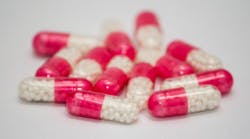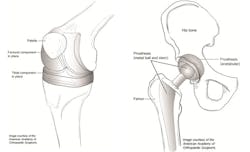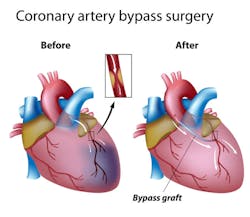What you need to know about dental antibiotic prophylaxis
My inbox gets a lot of these questions:
“Are you sure about the information about prophylactic antibiotics for joint replacement therapy?”
“What is the most recent guideline about antibiotic prophylaxis for joint replacement? I heard that the recommendations changed.”
“I thought that the patient had to take antibiotics for 2 years or life?”
Considering that over one million Americans have a hip or knee replaced each year, (1) this topic of premedication needs clarification.
You will find your answer very shortly. But let’s start from the top. What is antibiotic prophylaxis? Antibiotic prophylaxis refers to medication which is given in preparation for an operation or other treatment. During some dental treatments, bacteria from the mouth enter the bloodstream. In most people, the immune system kills these bacteria. But in some patients, bacteria from the mouth can travel through the bloodstream and cause an infection somewhere else in the body. Antibiotic prophylaxis may offer these patients extra protection.
This article is an effective summary of the most important highlights the dental professional needs to know for joint replacement, infective endocarditis, stents, and coronary bypass surgery.
Joint replacement
Joint replacement is accomplished by removing a damaged joint and putting in a new one. A joint is where two or more bones come together, like the knee, hip, and shoulder. Sometimes, the surgeon will not remove the whole joint, but will only replace or fix the damaged parts. Joint replacement is becoming more common. Up until 2012, antibiotics were recommended for two years after surgery or for a lifetime.
Guidelines
In patients with a history of complications associated with their joint replacement surgery who are undergoing dental procedures that include gingival manipulation or mucosal incision, prophylactic antibiotics should only be considered after consultation with the patient and orthopedic surgeon. (2)
The 2015 ADA clinical practice guideline states that "In general, for patients with prosthetic joint implants, prophylactic antibiotics are NOT recommended prior to dental procedures to prevent prosthetic joint infection.” (3)
Explanation
In 2012 and 2014, a series of scientific recommendations and systematic reviews found little evidence that dental procedures are associated with prosthetic joint implant infections. (Side note: systematic review refers to the summary of carefully designed healthcare studies and is considered to be evidence of high level.) Other factors such as the potential harms of antibiotics including risk for anaphylaxis, antibiotic resistance, and opportunistic infections such as Clostridium difficile were included in creating the new recommendation.
Supporting resources
- 2017 ADA Chairside Guide. American Dental Association website.
- Antibiotic Prophylaxis Prior to Dental Procedures. American Dental Association website.
- American Academy of Orthopaedic Surgeons/American Dental Association. Prevention of Orthopaedic Implant Infection in Patients Undergoing Dental Procedures: Evidence-based Guideline and Evidence Report, 2012.
- Evidence-based clinical practice guideline for dental practitioners. Report of the American Dental Association Council on Scientific Affairs, 2015.
Antibiotic dosage and schedule (4)
- For patients not allergic to penicillin: cephalexin, cephradine, or amoxicillin 2 grams orally 1 hour prior to dental procedure.
- For patients allergic to penicillin: clindamycin 600 mg orally 1 hour prior to dental procedure.
Infective endocarditis
Infective endocarditis (IE), also called bacterial endocarditis (BE), is defined as an inflammation of the endocardial surface of the heart. Endocarditis generally occurs when bacteria or other germs from another part of the body enter and spread through the bloodstream and attach to damaged areas in the heart. If left untreated, endocarditis can damage or destroy the heart valves and can lead to life-threatening complications.
Guidelines
Prophylactic antibiotics are recommended for patients undergoing dental procedures that involve manipulation of gingival tissue or the periapical region of the teeth, or perforation of the oral mucosa and have the following conditions:
- “A prosthetic heart valve or who have had a heart valve repaired with prosthetic material.
- A history of endocarditis.
- A heart transplant with abnormal heart valve function.
- Certain congenital heart defects including:
- Cyanotic congenital heart disease (birth defects with oxygen levels lower than normal) that has not been fully repaired, including children who have had a surgical shunt and conduits.
- A congenital heart defect that's been completely repaired with prosthetic material or a device for the first six months after the repair procedure.
- Repaired congenital heart disease with residual defects, such as persisting leaks or abnormal flow at or adjacent to a prosthetic patch or prosthetic device.”5
Explanation
Numerous scientific evidence concluded that the risk of adverse reactions to antibiotics generally outweighs the benefits of prophylaxis for many patients who would have been considered eligible for prophylaxis in previous guidelines. Concern about the development of drug-resistant bacteria also was a factor for the simplified guidelines.
The 2014 ADA/ACC (American College of Cardiology) guidelines add that optimal oral health is maintained through regular professional dental care and the use of appropriate dental products, such as manual, powered, and ultrasonic toothbrushes; dental floss; and other plaque-removal devices. (6)
Supporting resources
- Infective endocarditis. American Heart Association website.
- 2014 AHA/ACC Guideline for the Management of Patients with Valvular Heart Disease: A Report of the American College of Cardiology/American Heart Association Task Force on Clinical Practice Guidelines. Circulation 2014.
- Antibiotic Prophylaxis Prior to Dental Procedures. American Dental Association website.
Antibiotic dosage and schedule (7)
- 1 hour before the procedure to allows the antibiotic to reach adequate blood levels. However, if the dosage of antibiotic is inadvertently not administered before the procedure, the dosage may be administered up to 2 hours after the procedure.
- Patients not allergic to penicillin: oral amoxicillin 2g (50 mg/kg for children)
- Patients allergic to penicillin or ampicillin: oral cephalexin 2g (50 mg/kg for children) or clindamycin 600 mg (20 mg/kg for children)
Stent
A stent is a tiny wire mesh tube that helps keep the coronary arteries open, which in turn reduces the chance of a heart attack. It is placed with the use of a balloon catheter that expands and locks the wire mesh. The stent is left permanently.
Guidelines
Antibiotic prophylaxis for dental procedures is NOT recommended for patients with coronary artery stents. (7)
Explanation
Primary prophylaxis for stent placement is not routinely advocated because the overall infection risk is extremely low. In addition, dental, respiratory, gastrointestinal, or genitourinary procedures have not been implicated as causes of bacteremia that have accounted for stent infections. (8)
Supporting resources
Coronary artery bypass surgery
Coronary bypass surgery is a surgical procedure that diverts the flow of blood around a section of a blocked or partially blocked artery in the heart by creating a new pathway to the heart. During a coronary bypass surgery, a healthy blood vessel is taken from the leg, arm, or chest and connected to the other arteries in the heart so that blood bypasses the diseased or blocked area.
Guideline
Antibiotic prophylaxis for dental procedures is NOT needed in persons who have undergone a coronary artery bypass surgery. (7)
Explanation
There is no evidence that coronary artery bypass graft surgery is associated with a long-term risk for infection. (7)
Supporting resources
I would like to conclude this summary by emphasizing the need to utilize the evidence supporting the guidelines. I purposely left the details and background information to create a concise article that can effectively provide answers. If you find colleagues and patients who doubt your decisions, be ready to provide scientific proof that can back your professional judgments. Antibiotic prophylaxis guidelines for joint replacements seem to be especially controversial. So, share this article and print out copies for your dental office. Evidence-based decision making protects you, the dental professional and patient.
References
1. Joint Replacement Surgery: Health Information Basics for You and Your Family. National Institute of Health website. https://www.niams.nih.gov/health_info/joint_replacement/. Accessed May 16, 2017.
2. Antibiotic Prophylaxis Prior to Dental Procedures. American Dental Association website. http://www.ada.org/en/member-center/oral-health-topics/antibiotic-prophylaxis. Updated March 17, 2017. Accessed May 16, 2017.
3. Sollecito TP, Abt E, Lockhart PB, et al. The use of prophylactic antibiotics prior to dental procedures in patients with prosthetic joints: Evidence-based clinical practice guideline for dental practitioners - a report of the American Dental Association Council on Scientific Affairs. J Am Dent Assoc. 2015; 146(1):11-16 e8.
4. Quinn RH, Murray JN, Pezold R, Sevarino KS. The American Academy of Orthopaedic Surgeons Appropriate Use Criteria for the Management of Patients with Orthopaedic Implants Undergoing Dental Procedures. J Bone Joint Surg Am. 2017; 99(2):161-63.
5. Infective endocarditis. American Heart Association. http://www.heart.org/HEARTORG/Conditions/CongenitalHeartDefects/TheImpactofCongenitalHeartDefects/Infective-Endocarditis_UCM_307108_Article.jsp#.WRT169Lyv6Q. Accessed May 16, 2017.
6. Nishimura RA, Otto CM, Bonow RO, et al. 2014 AHA/ACC Guideline for the Management of Patients with Valvular Heart Disease. A Report of the American College of Cardiology/American Heart Association Task Force on Practice Guidelines. Circulation. 2014;129(23):e521-643.
7. Wilson W, Taubert KA, Gewitz M, et al. Prevention of Infective Endocarditis. Guidelines from the American Heart Association. Circulation. 2007;116:1736-1754. doi: 10.1161/CIRCULATIONAHA.106.183095.
8. Baddour LM, Bettmann MA, Bolger AF, et al. Nonvalvular cardiovascular device-related infections. Circulation. 2003;108(16):2015-31.
Claire Jeong, RDH, BS, MS, is an educator and entrepreneur. She founded StudentRDH and SmarterDA, which offer dental hygiene and dental assisting exam review courses of the highest quality through the latest technology. According to some students, studying is now “addicting.” Claire was invited on various podcasts to speak about memory techniques and learning efficacy, topics she also promotes through articles, speeches, e-books, and blogs. Claire has a Master’s Degree in Administration from Boston University and a Dental Hygiene Degree from Forsyth School of Dental Hygiene in Boston.
About the Author

Claire Jeong, MS, RDH
Claire Jeong, MS, RDH, is an entrepreneur, author, educator, researcher, and international speaker. She is the founder of SmarterDA/StudentRDH–dental assisting and dental hygiene exam prep solutions. Through her live and online courses, Claire has helped thousands of people gain valuable dental knowledge and clinical skills. She authored the e-book WakeUp Memory, which teaches how to use the brain and remember anything. Claire is regularly invited to podcasts and conferences as a key opinion leader. She also provides guidance to companies to reach the younger generation of dental professionals. Email her at [email protected].






